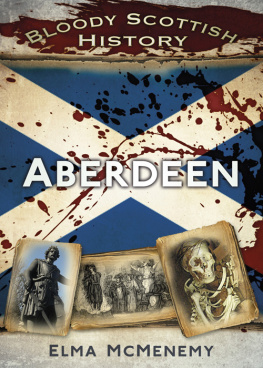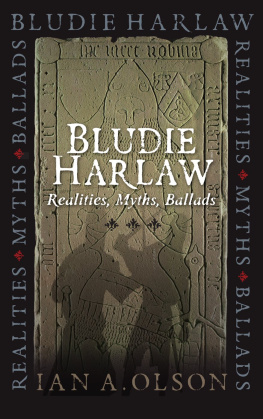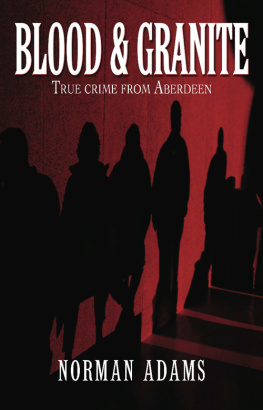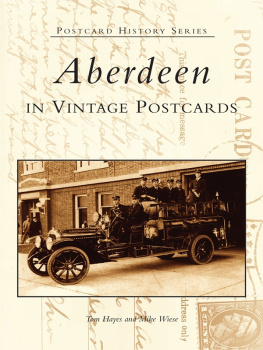
In memory of my Auntie Anne,
Annie Hutton Numbers, MA, BSc, PhD, 18971988,
one of the spinster generation.

Without her unfailing guidance and encouragement in my early life I would have achieved very little.
CONTENTS
I HAVE REALLY enjoyed writing this, have learned a huge amount and have been amazed and humbled by the ready assistance offered by so many people but then, Aberdeen is that sort of place.
I first mentioned the book at a meeting of the Aberdeen City and Shire Ancestral Tourism Partnership and was instantly given ideas and offers of help. Thanks to all of you, in particular Phil Astley, Aberdeen City Archivist; Fiona Watson, Archivist to NHS Grampian; Jean Shirer of Aberdeen & NE Scotland Family History Society; and Andrew MacGregor, Deputy Archivist, University of Aberdeen Library, Special Collections and Museums. John Edwards, at that time Head of Collections, Aberdeen City Museums and Galleries, ensured his enthusiastic staff helped however they could: Dr Christopher P. Croly, Aberdeen City Historian, readily shared his own carefully researched information I couldnt have done this without your help! Meredith Greiling, Curator of Maritime History; Judith Stones, Lead Curator, Local History and Archaeology; and Jenny Brown, Curator, Industry, also helped in different ways. Jesper Ericsson, Curator of The Gordon Highlanders Museum, was an absolute star, sharing information, providing illustrations and checking details for three chapters in no time flat.
Organisations, business acquaintances, colleagues, friends and family also helped with particular chapters, including Historic Scotland; Blairs Museum Trust; Captain Daniel Stroud and Dianne Insh of Aberdeen Harbour Board; Dr Arthur Winfield of The Open Space Trust; Jake Molloy of the RMT union representing offshore workers; Regina Erich; Blue Badge Guide Pam Wells; and Bev Clarke, serial ancestral visitor, living in Tasmania but also firmly rooted in north east Scotland, who happily allowed me to use some of her painstaking family research. My sister, Lorna Numbers, RRC (Colonel retd QARANC), explained with her usual clarity points of medical and military detail, while my niece Rachael McMenemy refreshed my memory on Shakespeares Macbeth .
Several people preferred not to be named, but I certainly could not have done this without their support. A special retired soldier who, together with his father-in-law, prevented potential military combat faux pas; two helicopter pilots, one retired, the other still flying enthusiastically offshore; and an amazing friend who patiently read and re-read every word, checked details and corrected grammar, punctuation and ambiguities. You all know who you are thank you!
To Cate Ludlow of The History Press, thank you for asking me, and for your unfailing support, patience and flexibility.
Sincere thanks to my husband Brian for his encouragement, wielding his teachers red pen as required and for countless cups of coffee, glasses of wine, the occasional inspirational malt whisky and for understanding when so often I couldnt do other things; apologies for trying to fit too much work into too few hours again! And finally, hugs to my two lovely Deerhounds Sula and Gigha stress-busters extraordinaires.
Any mistakes are, of course, my own.
T HE ABERDEEN WE know today evolved from two distinct settlements surrounded by small villages, now all incorporated into the city. The two main settlements were very different.
To the north, by the River Don, a town grew up which we now call Old Aberdeen; this developed as a centre for Christianity and learning. St Machar, a disciple of St Columba, brought Christianity here about the year AD 580. Tradition tells that Columba told Machar to travel from Iona across Scotland until he came to a place near the sea and close to a river which flowed in the shape of a bishops staff. Certainly, the place where he chose to settle and build his simple church was less than a mile from the North Sea and on land close to the River Don, where he is believed to have performed baptisms. Today, the Cathedral Church of St Machar stands on the same site. One of the worlds oldest granite cathedrals, most of the present building dates from the 1300s and early 1400s. It was here in Old Aberdeen, in 1495, that Bishop William Elphinstone founded a university for the north of Scotland. Kings College, named after King James IV who supported the university financially, was an important part of what became a prosperous burgh. Today, it is the main campus for the University of Aberdeen, with 500-year-old Kings College Chapel very much at its heart.
Meanwhile, to the south, the estuary of the River Dee provided a natural harbour. In 1136, King David I granted the bishops and clergy of Old Aberdeen the right to demand dues or taxes from the ships using the harbour. The port ensured the towns growth and prosperity and attracted merchants, traders and shipbuilders and also Vikings, pirates and the English! It was here in this merchant and trading town that Aberdeens second university was founded in 1593. Named Marischal (say it marshall) College after its founder George Keith, the Earl Marischal of Scotland, it was a Protestant rival for the Catholic Kings College in Old Aberdeen. For centuries, Aberdonians have been proud to boast that their city had two universities at a time when there were only two in the whole of England, at Oxford and Cambridge, albeit each had several colleges.
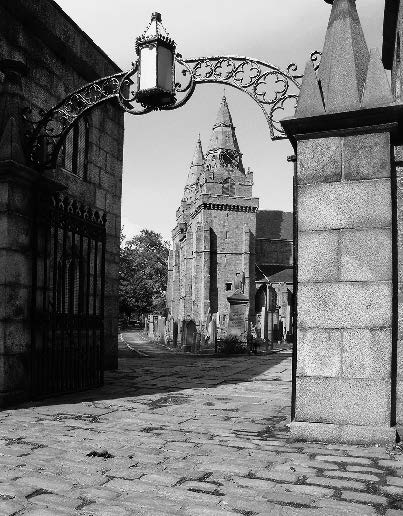
Cathedral Church of St Machar, Old Aberdeen. (Authors collection)
ROYAL THIEVERY!

Around 450 years ago, with the future King James VI (later James I of England) still an infant, the Regent, the Earl of Moray, sent his henchmen to Old Aberdeen. Their instructions were to take the lead from the roof of the old Roman Catholic St Machars Cathedral, then disused and neglected. The Regent planned to sell the lead to raise funds to pay his army. His men took not only the lead but also the huge bronze bells from the great central tower. All this booty was carried to Aberdeen Harbour and loaded onto a ship. But no sooner had the vessel sailed, than a huge storm blew up and the ship sank to the bottom of Aberdeen Bay. It is said it still lies there today with its cargo intact because it rests at the outflow of the citys old Victorian sewage system!

Aberdeen benefited greatly from its natural resources fish from the sea and rivers, produce from its hinterland and high-quality granite. This fine silver stone was used not only for buildings, bridges and mansions throughout the city, the base of the famous Bell Rock Lighthouse and the piers of the Forth Rail Bridge, but was also sent farther afield to London for the Embankment, Waterloo Bridge and the Cenotaph, and to Paris for LOpra.
Town, the trading port, and Gown, the University and Old Aberdeen, developed an even closer relationship. First, in 1860, the two universities united to form the University of Aberdeen, then in 1891 Old Aberdeen and New Aberdeen came together under one Town Council. Old Aberdeens beautiful Georgian Town House was no longer needed.
Like many other British cities, as Aberdeen expanded it absorbed nearby villages, including Woodside, Fittie (sometimes called Footdee), Ferryhill and more recently Cove Bay, Bucksburn, Dyce, Cults and Culter. Unlike most other cities, however, Aberdeen has always been inextricably linked to its hinterland, not only the Aberdeenshire of old but also the other counties which now make up the administrative area of Aberdeenshire the Mearns/Kincardineshire, Buchan and Banffshire. During the 1860s and 70s, the rebuilding of the Town House in New Aberdeen included a shared meeting hall. Known as the Town and County Hall, this was used both by Aberdeen Town Council and Aberdeen County Council. This shared facility was the result of a plan to save money perhaps it was one of many things which gave rise to the stories about Aberdonians being mean?
Next page
